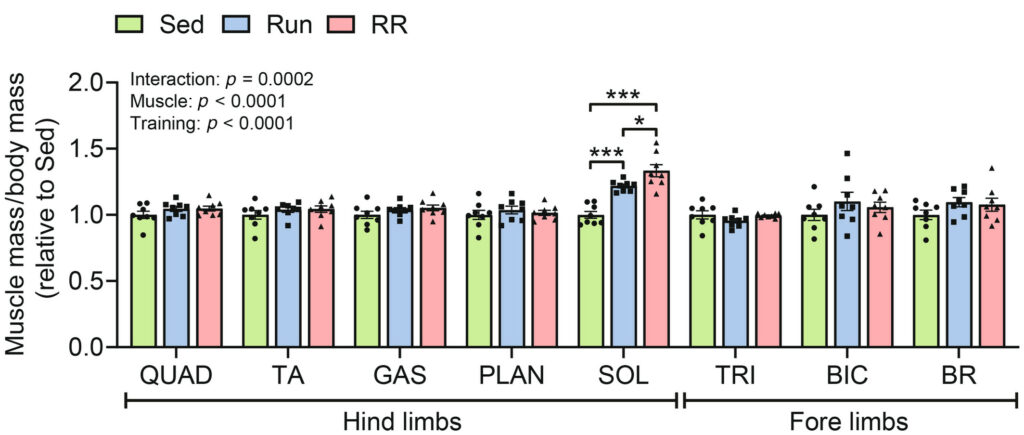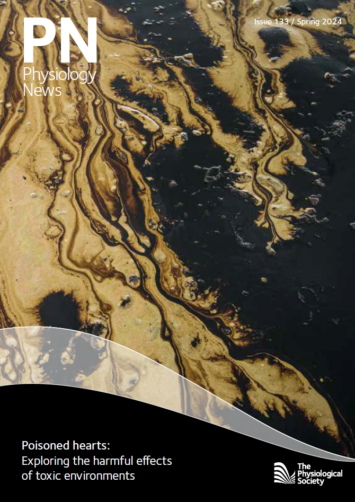
Physiology News Magazine
Searching for why and how the body adapts to exercise training
Physiological Report’s Paper of the Year Award 2023
Features
Searching for why and how the body adapts to exercise training
Physiological Report’s Paper of the Year Award 2023
Features

Dr Aurel Leuchtmann
Dr Aurel Leuchtmann is a molecular biologist specialising in how our bodies respond to exercise and how musculoskeletal tissues adapt to training. His curiosity about human physiology, specifically understanding the influence of exercise and the reasons why it benefits us, led to him studying Health Sciences and Technology at ETH Zurich, Switzerland. He then went on to complete a PhD in Molecular Biology at the Biozentrum of the University of Basel, Switzerland, working on a range of projects aimed at elucidating the nuances of training adaptation and the functional dynamics of adult and ageing skeletal muscle.
How does the body respond to different training regimens? Dr Aurel Leuchtmann tells us about his PhD research exploring a mouse model to study endurance, muscle mass and strength gains to exercise. The project, it turns out, would win him and his co-authors Physiological Report’s Paper of the Year 2023.
In January, Aurel Leuchtmann and his co-authors were awarded Physiological Report’s Paper of the Year Award 2023, a new Prize launched by the journal to recognise the research papers of highest sound science quality published in the year December 2022 to November 2023.
Aurel and his co-authors were working on identifying specific training interventions to help researchers select the best models to study the factors and mechanisms for exercise training adaptations. Exercise could be used as a preventative approach against a range of diseases and to improve quality of life. However, the mechanisms explaining the benefits need to be fully understood to better allow health professionals to develop and use exercise-based strategies to support health management, disease prevention and ageing.
A surreal moment
“I was so surprised to receive the email informing me of the prize that it took me a few moments to put aside my scepticism and assure myself that the award was genuine! I thought our study was quite niche, so I am overjoyed that the research is appealing to others. It verifies to me and my co-authors that the work is interesting and valuable for the community. I feel especially honoured as this paper was the first to receive the prestigious ‘Paper of the Year’ award.”
We discover how Aurel’s interest in exercise physiology began early in life and how his sporting activities propelled his academic pursuits.
How can knowledge of physiology boost athletic potential?
Aurel was an athletic child. Playing a lot of sports during his childhood and teens years made him curious about how training could influence or enhance his potential as an athlete. “I wanted to understand how specific training protocols in combination with certain nutrients could affect my performance. From a young age, I wanted to know the physiological mechanisms that lead to adaptation to exercise training.”
After high school, he was torn about what to study. It was a choice between two passions: medicine, or health sciences.
“My first interest was medicine, but once I found out about a new interdisciplinary study programme ‘Health Sciences and Technology’ at ETH Zurich, Switzerland, I knew it was the course for me.” The degree was research-oriented and focused on education in medical sciences at the interface of human physiology, health, and technology. Aurel wanted to concentrate on the study of humans, rather than plants and other animals, which can be the case with many biology courses.
“I was fortunate that we were taught by very good professors. I think this does inspire and nurture our interests.” One teacher had a memorable and thought-provoking style of teaching. “He didn’t just lecture, he asked questions. Everyone in the lecture theatre was made to think about potential explanations about a phenomenon. Only when the lecturer was satisfied with our answers, did he start to reveal the actual mechanism or concept that was behind what we were studying.” It was this course that really piqued his interest in using research to answer interesting questions.
I thought our study was quite niche, so I am overjoyed that the research is appealing to others. It verifies to me and my co-authors that the work is interesting and valuable for the community. I feel especially honoured as this paper was the first to receive the prestigious ‘Paper of the Year’ award
Exercise is beneficial, but how does it change our bodies?
When it came to his Master’s thesis, Aurel saw an opportunity to explore one of the first questions that motivated his career in physiology. Setting out to answer, how does the body adapt to exercise? “I studied muscle biopsies in the lab to investigate how different exercise training affected the adaptation of the muscle,” he explained. We found a key adaptation was the buildup of blood vessels. But it didn’t tell us what was controlling the process.
Aurel went on to complete a PhD using animal and cell models to go deeper into the molecular mechanisms. It was during his time as a PhD student that he and his colleagues carried out the project that led to their award-winning paper.
We know that exercise is good for the body, showing cardiorespiratory, neural and metabolic benefits. Yet we still don’t know the exact mechanisms that control these benefits, in particular when it comes to understanding how muscles grow and how strength increases in response to training.
“Initially, we wanted to study muscle hypertrophy (growth of an organ or tissue by increasing the size of its cells) and strength gains. But when we were discussing study protocols that we could use to study these specific exercise training adaptations, we realised that there are no standardised or well characterised training interventions.”
Using a mouse training model
Aurel and the team set out to characterise the interventions and adaptations. They studied male mice running in wheels, a popular model for endurance training. To simulate resistance training, magnetic brakes were added to the wheels to make it harder to rotate. The mice on these loaded wheels would have to work harder to run. The two training regimes would serve as useful models linking to human exercise training, allowing the team to investigate muscle growth and strength.
“The wheels let mice follow their natural activity patterns. The mice are free to choose when they run, how long for, and at what time of the day. Since mice are nocturnal, they tend to choose to run at night. The wheels offer a huge advantage because we could eliminate external factors that could otherwise influence the behaviour or adaptations, such as external stressors from a forced setting or human presence. It can be seen as more ecologically valid than training mice on a treadmill, where researchers might have to nudge or encourage the mouse to run if the timing of the activity does not fit with its natural activity pattern.”
After 10 weeks, mice training on free-running wheels (the low-resistance group) were compared to mice running on high resistance wheels (high-resistance group). Mice in both training groups put on more lean mass than fat compared to sedentary mice (see Fig.1), and both similarly improved their VO2 peak, (a fitness marker measuring the rate of oxygen consumed at the peak level of exercise). “We also found similar adaptations in mitochondria and blood vessels of the plantar flexor muscles. This is the main group of muscles responsible for the angle of the foot and creating the motion enabling walking and running. So, it is not surprising that improvements occurred in both groups,” says Aurel.

Treadmill endurance test
The mice were trained using wheels but were tested on the treadmill because it is easier to control.
“The low-resistance mice outperformed the high-resistance group in the endurance test. They had higher endurance capacity, which means they were better at running for longer periods,” says Aurel. However, the team found that the high resistance training mice on the loaded wheels had greater muscle strength. “They were quite a bit stronger than we expected and showed greater hypertrophy in the soleus (calf) muscle, one of the major muscles involved in running.”
Calf muscle growth was greater for the high-resistance mice, but the low-resistance mice also showed a robust increase in the size of the calf muscle (see Fig.1). Aurel and his team were surprised by this response to endurance training alone and how quickly the muscle grew in response to this training regimen.
During the 10 weeks, the high-resistance group ran less overall than the low-resistance group. The mice in this group trained fewer times but experienced more intense exercise bouts because of the higher resistance compared to the low resistance group, who could easily rotate the wheel, and so would frequently return to it. “Despite this, both forms of training had a similar impact on fitness, possibly because the total amount of external work was comparable. The high-resistance group had a lower training volume with lower time investment but yielded the same cardiovascular adaptations.”
By investigating systematic and functional adaptations at the molecular and cellular level in response to endurance compared to resistance training we have provided an optimal training paradigm for different exercise studies
Endurance vs resistance training
“We don’t yet know why the low-resistance mice were better endurance runners than the high-resistance group. As we saw similar adaptations in the heart and the muscles, we assumed that they would perform the same. One potential explanation could be that the training style naturally habituated the low-resistance mice to running longer distances and at higher speeds.”
“By investigating systemic and muscular adaptations at the molecular and cellular level in response to endurance compared to resistance training we have provided optimal training paradigms for different exercise studies. Our results will help researchers design and select training interventions of animal models to support the discovery of factors and mechanisms controlling exercise adaptation. These could eventually translate to human studies,” explains Aurel.
What advice has helped you in your academic career?
“It is difficult to nail down one specific piece of advice because you learn so much while carrying out your experiments and from failing. Both are extremely useful for your career development. But, if I had to pick one, then I would encourage you to get to know your lab members as well as people across your department.”
Aurel was given this advice by his supervisor on his first day of his first lab internship as a Master’s student. Top of his long task list was the mission to talk to everyone in the lab!
“I was to ask them about their work, what techniques they use and so forth. It is an excellent way to get to know who you can seek help from when needed, or who you should ask for feedback about your research. You gain novel interpretations of your work and good ideas of changes you could make.”
Read Aurel’s full research paper at physoc.onlinelibrary.wiley.com/doi/10.14814/phy2.15701
